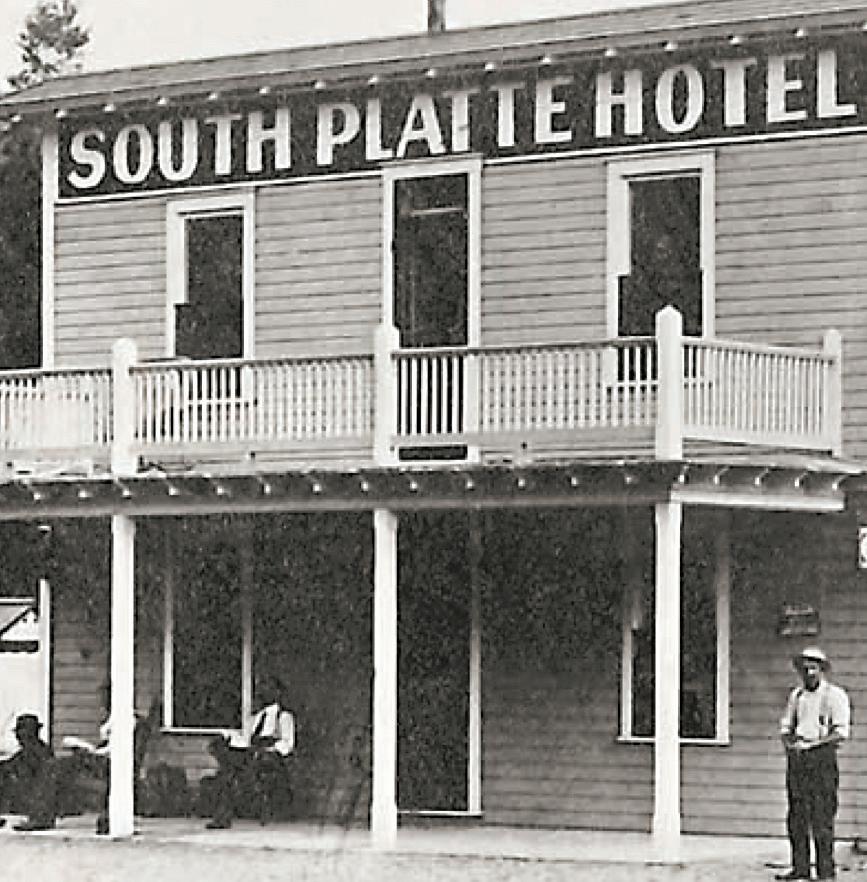
5 minute read
HOTEL
tacted a lot of local organizations to get them mobilized and aware of the situation.”
Among the organizations interest- ed in preserving the building are the Evergreen Mountain Area Historical Society, the Conifer Historical Society, the Pine Elk Creek Improvement Association and Je erson County Open Space.
Steinle hopes the organizations can meet with Denver Water ocials and put their heads together to come up with a plan.
“Our next step is to contact the decisionmakers at Denver Water and have a discussion of what they are amenable to do,” Steinle said.
“Hopeful we can work with them in the near future and keep them from tearing it down and gure out what to do with it.”
Colorado Preservation Inc. will facilitate and assist the local organizations with nding a solution to keep the building, said Endangered Places Director Katie Peterson, who noted that it takes local community initiative to preserve historic sites.
She said since the hotel was so close to the Colorado Trail and the South Platte River, options should be available to keep the building.
According to Jose Salas, a Denver Water spokesman, Denver Water bought the hotel building because it would be within the area underwater with the proposed Two Forks Reservoir, which ultimately was never built.
“With no waterworks purposes for Denver Water to warrant the expenditure of ratepayer funding for building repairs, the structure has progressively deteriorated over the last four decades and is currently extremely unsafe,” Salas wrote in an email. “Denver Water has installed fencing to deter the public from trying to enter the unsafe structure while we go through the process of determining its future.”
He said Denver Water understood the site’s historic signi cance and wanted to work with other groups to determine potentially viable options, and no decisions have been made.
Hotel history
e community of South Platte was at the con uence of the North Fork of the South Platte River. According to Preservation Colorado, the hotel originally was constructed in 1887 by Charles Walbrecht and his wife Millie, an example of a workingclass resort hotel. In its day, the hotel o ered 14 rooms to stagecoach passengers and train passengers on the Denver, South Park and Paci c Railroad narrow-gauge line.
Steinle said many communities sprang up in the late 1800s along the railroad, especially between Bu alo Creek and Pine Grove, a reminder of how intense railroading was in Colorado and how important the railroads were to the state’s economy. e hotel also operated a post of- ception in the current law for private property and repeal the minimum population density requirement from 100 people or more per square mile to 35 dwellings or more per square mile. is number is an amendment to the bill decided upon with collaboration between local sheri ’s departments. e bill was presented by Rep. Judy Amabile, D-Boulder, and backed by Sen. Dylan Roberts, D and Sen. Sonya Jaquez Lewis, D. e bill itself was born out of a small community in unincorporated Clear Creek County in the Idaho Springs neighborhood St. Mary’s Glacier, which has around 300 homes, according to residents.
In spring 2021, Clear Creek County Commissioners, law enforcement and other local agencies started to get calls out of the St. Mary’s Glacier area.

Frank Brown is a homeowner in the area. He testi ed at the rst hearing for the bill.
“As soon as the rearm discharging starts, it’s like an egregious end to all of the peace, the quiet, there’s automatic weapon re, there’s semiautomatic, and it’s so loud animals take o ,” he said.


Beth Ramsey is a part-time resident of St. Mary’s Glacier, and an experienced gun owner and user. She testi ed on Feb. 8 in support of the bill.
“We are gun owners, we are target shooters,” she said. “What we are seeing in St. Mary’s Glacier on a third-acre lot is wholly unsafe.”
Ramsey recalled shooters in the neighborhood using pine trees as backstops, ring large caliber weapons.
“ ey were spraying bullets,” she said.
St. Mary’s Glacier community members reached out to Amabile to seek a bill when they saw no results from local government agencies in Clear Creek County.

Taylor Rhodes, executive director of Rocky Mountain Gun Owners, testi ed against the bill on Feb. 8, claiming it to be an attack on the Second Amendment. e Board of County Commissioners would only be able to do so after holding a notice hearing for the pub- lic within their respective counties. e bill will now advance to the oor of the House and must pass through the legislature by mid-May to have a chance at approval by the Governor. ce, and by 1900 the town, population 40, included the hotel, railroadrelated businesses and a general merchandise store. Five years later the Walbrechts expanded the hotel to include a saloon.
“ is bill is a preemptive condemnation of all Colorado gun owners as irresponsible hooligans incapable of shooting responsibly on their property,” he said in his testimony. is bill, while inciting claims of amendment violations from gun activists, would only provide counties the option to enforce the ban on rearm discharge in certain areas.
“It’s a little frustrating, because the safety, or lack thereof, has nothing to do with the type of local government that serves you and everything to do with the density of the neighborhood,” Clear Creek County Commissioner George Marlin said.
“Peace and safety? Everyone deserves that,” Marlin said.

The community of South Platte was bustling 100 years ago.

Westall Monument near the South Platte community. is project was successfully completed in 2014 and recognized by the Je erson County Historical Commission.
According to legend, the hotel was set on re and burned to the ground in 1912. It was replaced with the structure that is still standing today, according to Preservation Colorado.
Student involvement

It’s not just area historical societies who are interested in preserving the South Platte Hotel. In the 2012-13 school year, West Je erson Middle School English teacher Frank Reetz and a team of students embarked on a project to restore the Billy
With that success, Reetz and his students began studying the South Platte Hotel, and students wrote essays on what should be done with the building, especially given its neglected state, that were published in 2018 in the periodical “Historically Colorado.”
While a few students said the building was too expensive to renovate and preserve, some suggested restoring it to a functioning hotel, preserving part of the building, or creating a park on the property as a way to preserve its history.
As one student put it: “We must protect this historic space from the forces of nature. We cannot let the destruction of this area. It is spiritual and special to the community.” elegibles pagar una parte de
Becoming and remaining part of a group is more than a choice. It is a demand of the human psyche. For all the blather about individualism, a tenet of secular American religiosity, belonging is the dominant human social gene. It is as instinctive to human behavior as walking, eating, and copulating. In fact, individualism is not part of the human social genome. It is a relatively modern idea, a philosophy, a choice birthed during the Age of Enlightenment.
More than we need to belong, we want to belong. Belonging to a group fosters good mental health and social cohesion, which is requisite for survival. Unbelonging induces loneliness, which leads to despair. One of the worst punishments that can be imposed on someone for not following a group’s rules is banishment or ostracization. Whether political exile, solitary con nement, or shunning, forced separation from a group or society can cause deep distress and potentially irreparable harm.
While some groups wither away, others last long after current mem-









